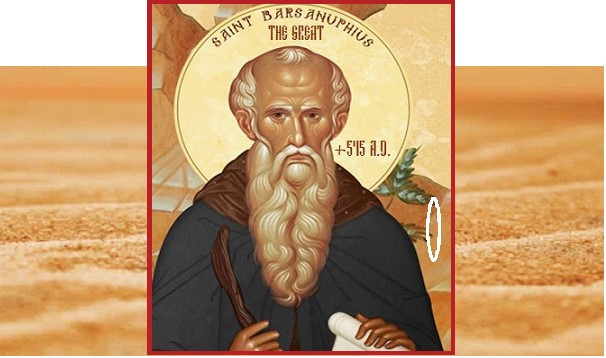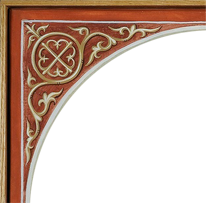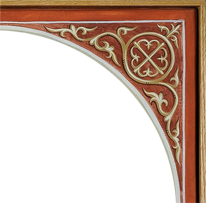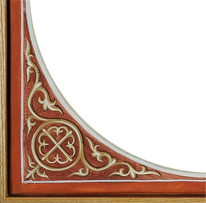
Saint Barsanuphius the Great was born in Egypt. The year of his birth is unknown. From his youth, he began to lead an ascetic life. Arriving at the cenobitic monastery of Abba Seridus, he built a small cell outside the monastery, where he lived in solitude.
Later, Saint John the Prophet, a disciple of Saint Barsanuphius, lived in his cell for eighteen years until his death. Saint John imitated the example of his spiritual father in silence, ascetic deeds and in virtue. Because of his gift of clairvoyance, he became known as “the Prophet.”
After a certain time, Saint Barsanuphius built another cell near the monastery. At the beginning of his solitude, the monastery sent him only three loaves of bread per week. He dwelt for fifty years in work and ascetic deeds.
When Patriarch Eustochios of Jerusalem heard about the ascetical life of Saint Barsanuphius, it seemed unbelievable to him. He decided to judge the merits of Barsanuphius for himself. Consequently, upon arriving at the saint’s small cell, he and the patrirach’s companions attempted to gain entry ther by digging beneath the wall of his shelter. In their futile attempt, flames suddenly burst out from beneath the cell, filling each with terror and thereby prompting all to flee on foot.
In his hermitage Saint Barsanuphius devoted himeself entirely to prayer, and he attained a high degree of spiritual perfection. We have manuscript accounts about the life, the deeds and talents of both Saints Barsanuphius and John. During the lifetime of Saint Paisius Velichkovsky, his texts were translated into the Moldavian and Slavonic languages. The publication of these manuscripts into the Russian, was completed in the nineteenth century by the Elders of Optina’s Entry of the Theotokos Monastery.
The precepts of Saints Barsanuphius and John the Prophet clearly show the degree of their moral perfection. However, few facts about their lives remain unknown. We do not know exactly when Saint Barsanuphius died. Some sources say the year of his death was 545, others say more cautiously before the year 600 A.D.
After spending a long time in seclusion Saint Barsanuphius, shortly after the death of Saint John the Prophet, served others by instructing them on the path to salvation. This was testified by Abba Dorotheus. Saint Barsanuphius occasionally replied to spiritual questions through either Saint John, or Abba Seridus who conveyed saint’s responses to their concerns.
In the answers of Saints Barsanuphius were guides in the spiritual life not only for his contemporaries, but also for subsequent generations. It is self-evident by the Saint Barsanuphius’ entries to observe the monk’s gradual spiritual ascent “from strength to strength.”
Through his fidelity to fasting, silence, guarding the heart, and unceasing prayer, Saint Barsanuphius attained the heights of holy through his ever-increasing humility, sound reasoning and fiery love. The Lord gave him the gifts of discernment, clairvoyance, and wonderworking. By the power of his prayers, he was able to free the souls of people from sins. Sometimes, he took the sins of others upon himself.
The venerable had the ability to know the dispositions of human hearts. This empowered him, by means of God’s infused grace, to offer appropriate advice according to the spiritual state of each person. Calling upon the Name of the Lord, it was reported that he raised the dead, he cast out demons, and healed incurable illnesses. Things that he blessed possessed Divine power and grace (for example, kukol or furrow-weed took away a monk’s headache). Even when the name of the holy monk, Abba Barsanuphius, was invoked mentally, he was known to have providing hope and healing to those who called upon his intercessory aid.
Through the prayers of Saint Barsanuphius the Wonderworker, God sent rain upon the earth, withdrawing His wrath from the multitudes of the people. The saint’s predictions always came true. Thus, he predicted that a certain monk, the Elder Euthymius the Silent, would be placed with him in a single grave, which indeed came to pass.Saint Barsanuphius acquired these gifts after many years of patiently enduring great temptations and serious illnesses.
Saint Barsanuphius the Great of Gaza survived his disciple and friend, but after St. John’s death embraced complete silence and refused to give answers to anyone. As the enduring spiritual legacy of Saints Barsanuphius and John, they co-authored a book entitled, Guidance Toward Spiritual Life: Answers to the Questions of Disciples. It remains one of the\great classics of monastic literature. Over the centuries, the counsels contained in the pages of this text has inspired many saints including Saint Theodore the Studite (+826 A.D.), Saint Simeon the New Theologian (+1022 A.D.) and countless monastics from both the East and Western Traditions.
All Sainst Shrine, here at Livonia’s Sacred Heart Byzantine Catholic Church, is privileged to preserve a significantly large bone relic from the rib (ex costa) of Saint Barsanuphius the Great. It is enclosed with one of the numerous double cabinets, lining the south wall of the church. Saint Barsanuphius, pray to God for us.




